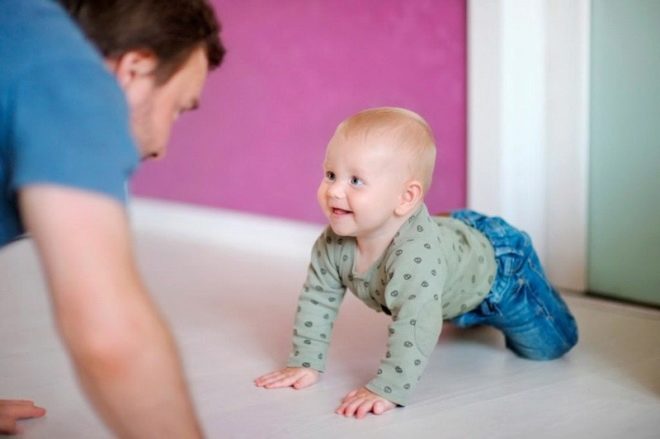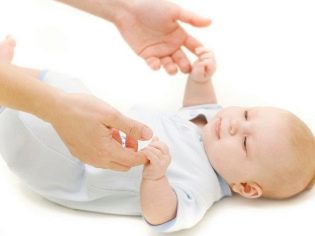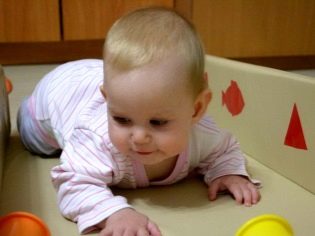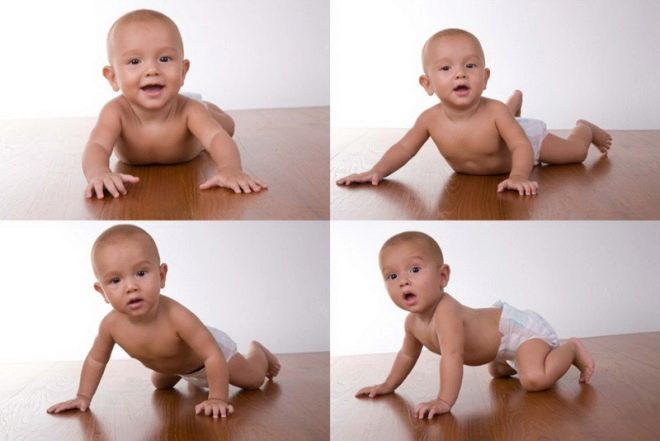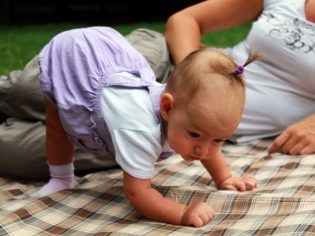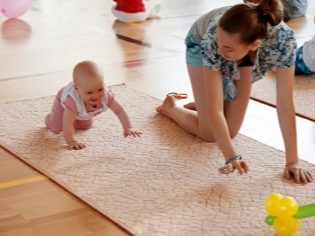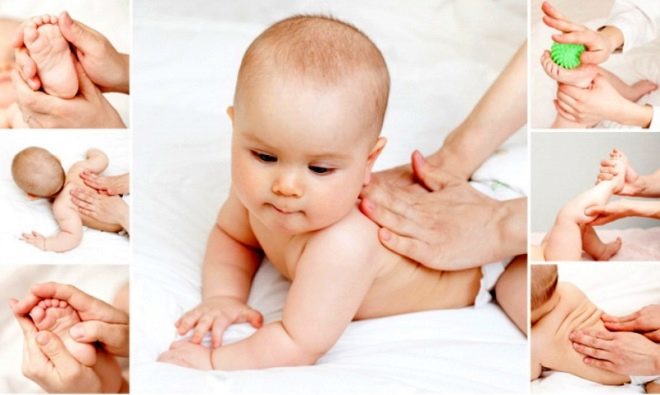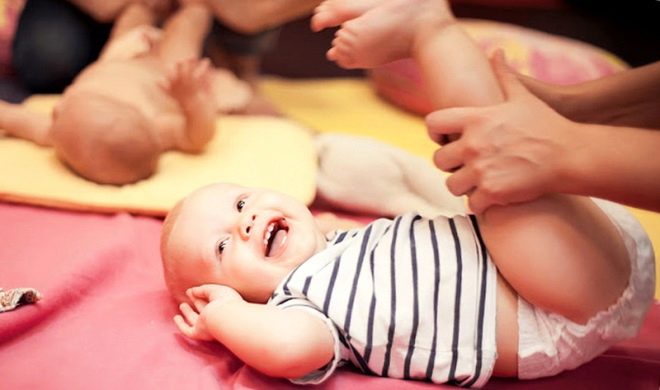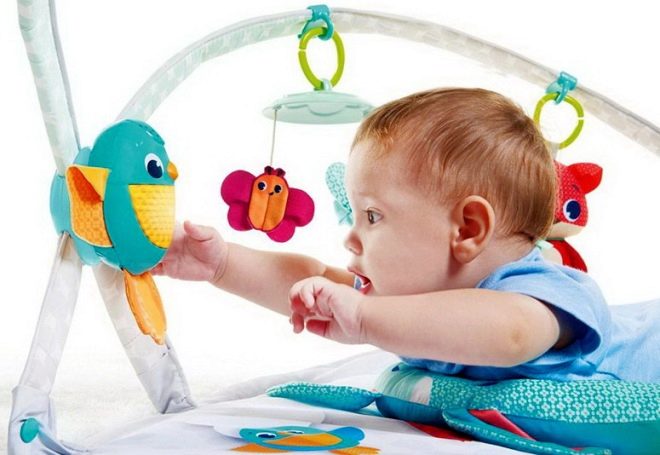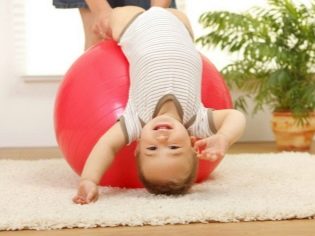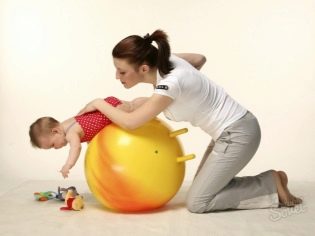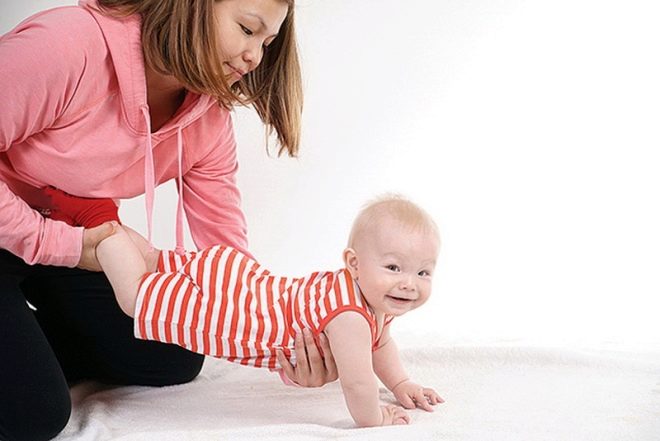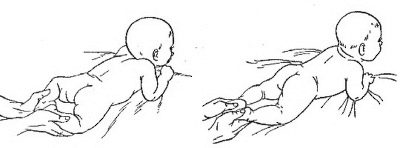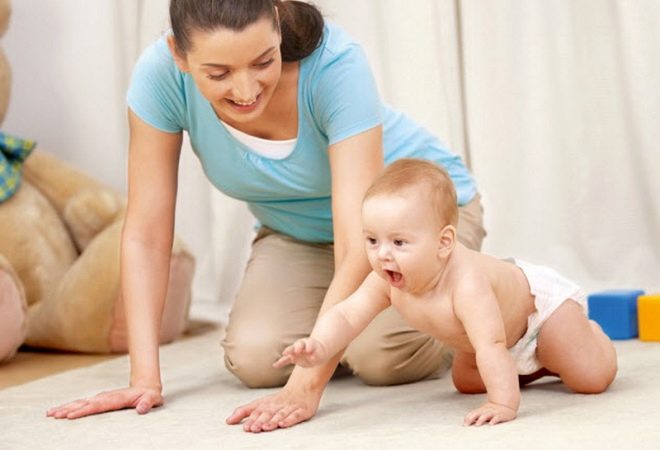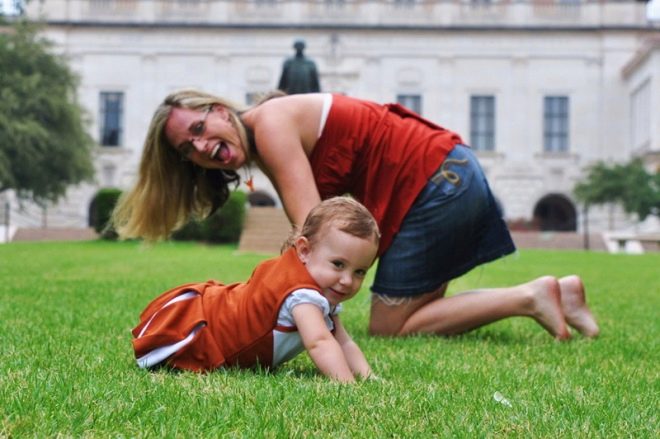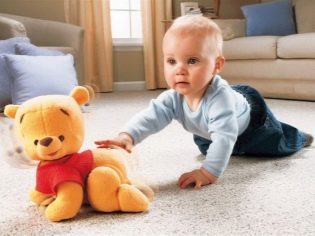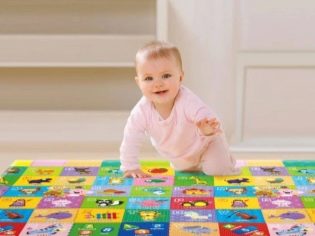At what age does the child begin to crawl, and what exercises contribute to this?
The child crawled - and this is an important event in his life. This skill is the first skill that allows you to move independently in space.
The crawling stage is necessary for the child's body to develop the musculoskeletal system, preparing it for a vertical load, which will replace the crawling. In this material, we will tell you when and how babies begin to crawl, and about what effective exercises will help parents encourage the child to crawl.
Norms and terms
The newborn does not have musculoskeletal skills, with the exception of unconditioned reflexes, which include grasping, straightening the body “to the string” when running along the spine, throwing pens to the sides and pushing the legs away from the plane in a vertical position. Only a few weeks after birth, the baby begins to make the first more or less conscious movements.
First, he learns to hold his head, to raise the upper part of the body on his hands in the supine position. Then he masters coups. Then comes the desire to sit and crawl - sometimes at the same time, sometimes in turns, and in any order.
In fact, the child in its development during the first year repeats in an accelerated mode the whole course of evolutionary changes that humanity underwent. The difference is that it took dozens of thousands of years for mankind to embark on the two lower limbs, and nature took only the first 12 months of its life for an individual person - your baby.
On average, pediatric norms indicate that a child begins to crawl at 5-9 months. The range of age is so big, because all the kids are very different. And crawling at five months, and mastering the new method of moving the body in space at 8 months is completely and incontestably normal.
Even if the baby completely refuses to crawl (there are such tots) this is not considered a deviation in the program of growth and maturing of the baby and should not cause great alarm in the mother and father.
In order to crawl, the child must first strengthen the muscles of the abdomen, chest, neck. A kid who has not learned to keep his head confidently, will not be able to crawl because of the immaturity of the muscle groups responsible for the crawling process, raising the torso on the arms and turning over on its side, back and belly. Only when the muscles and ligaments are ready for the development of a new stage, the baby will gladly accept gymnastics, exercises and other parental activities aimed at stimulating crawling.
Regarding the norms, it should be noted that they are rather average and so general that they are hardly applicable to individual babies. Do not worry if the child is ahead of them or behind. Each baby develops according to its individual program.
What affects the timing?
A child may not demonstrate any desire to crawl after six months, and there may be a lot of reasons for this. Be sure to take into account individual "circumstances". And they can be as follows:
- the baby was born prematurely;
- the baby has established and diagnosed neurological disorders;
- the kid leads an inactive lifestyle;
- the crumbs have a congenital melancholic or phlegmatic type of temperament (active and sometimes even restless sanguine and choleric people begin to move faster and more willingly, everything is interesting, whereas the phlegmatic is more interested in good nutrition and healthy prolonged sleep);
- the child has problems with overweight: boys and girls whose body weight exceeds the allowable age values, in general, with difficulty and much later than their peers, learn new motor skills;
- the child must have a suitable “habitat”: if it is constantly restricted to the outside of the crib or playpen, there will simply be no stimulus for crawling;
- the child has vision problems: visually impaired children cannot correlate the distances between objects and see distant targets, and therefore crawling is not stimulated.
Stages of skill development
The ability to sit or walk, almost all children look the same. And only crawling is a wonderful “space” for expressing an individual style: all children, if you carefully observe, crawl in different ways, as they like. The skill develops in stages, and at each stage this individual style will be clearly traced.
The skill is formed by its own laws, regardless of the style of crawling baby. Consider the basic stages of acquiring a skill.
On the stomach
Crawling on the tummy babies usually start first. This method does not require a baby of great physical exertion, it involves the muscles of the abdomen and back.
It’s easiest to learn how to learn a new way, because in this position the baby feels safe. Nothing threatens his balance and position in space. K, too, you can always relax and lie down in the usual pose - on the tummy, if you get tired to move forward.
The dates of the beginning of this stage are the earliest. On average, kids learn to move on the belly in 5-6 months. At the initial stage, the child needs quite strong muscles of the arms, because after a coup on the tummy, they need to learn to push off from the plane with their hands.
At this stage, babies rarely get targeted crawling forward. Most often, tots are amusing their parents with their attempts to move in a bellow to the side or back. This is considered to be completely normal, no adjustments to such a creep should be made.
On the abdomen involving the legs
About a month after mastering the movement on the belly, the child begins to understand that in order to achieve the goal in front of you, you need to move in her direction, because moving backwards or sideways does not bring the cherished toy one iota. Then most of the children begin to use the legs - they repel. It turns out the forward movement of the body forward, but for now the crumb is on the stomach.
As you improve the ability to push off with your feet at the same time, or quite alternately, a fully functional crawling forward on your stomach is formed, moreover, the child begins to realize that bent legs lift him above the plane, and he learns to stand on all fours. The basic (very conditional) timeframe for the start of the stage is 6-8 months.
On knees
As soon as the baby learns to carry the weight of the body on the legs and arms, it will begin to stand on all fours and sway. At the same time he will fall, it is painful to beat his chin and nose, and therefore already at this stage parents should take care that there is a crawling space in the house - with a soft floor covering, which will alleviate the setbacks.
It is impossible to force a child to crawl on all fours. The instinct of self-preservation clearly tells the toddler that in the absence of a sense of balance, one does not need to move anywhere. Therefore, the crumb will be as much on all fours as it needs to strengthen the muscles of the extremities, because they are now the main burden. On average, the period starts from 7-9 months. Its duration is purely individual.
On all fours with a permutation
This is the final stage at which the child, who has learned to assess his weight and balance on four points of support, begins to rearrange the limbs, at the same time distributing the weight to the other three or two limbs. At first, the kids rearrange their arms, tightening their legs behind them, then master the synchronized rearrangement of the arms and legs.
From this moment on, the child resembles the notorious “electro-broom”, which here, there and in the next room manages to be present almost simultaneously. This period will require special care from the parents of the baby’s safety. He already gets to the previously forbidden boxes, shelves, kitchen, stove and trash can. Be carefull.
Baby sex and crawling
Often in the forums on the Internet you can find statements from moms that girls begin to crawl before boys. It’s not quite right to blame male babies for laziness and inactivity. their muscular system and motivation develop no slower than girls.
The speed of the development of motor skills, according to official medicine, does not depend on the sex of the child. The opinion of mothers is nothing more than their personal observation of a limited group of children — of their child, neighbor, and child of a girlfriend. In the framework of global statistics, there is no definite advantage in physical development for girls. Children of both sexes have equal potential, provided that their health status, weight and social conditions in which they live are also approximately equal.
If the child does not want to crawl
There are children who are very upset by their parents that they absolutely do not want to crawl. They can be moved in alternative ways - for example, by jumping from a position on all fours, or rolling from side to side until they “reach” the goal. First of all, parents may have thoughts about possible developmental pathologies.
Do not panic. Watch your baby more closely. If in his movements he equally uses his limbs on the right and left sides, if during movement, even without crawling, the child equally coordinates the movements of the right and left hands and both legs equally, then there is nothing to worry about.
If there are no convulsions, paresis, “puffing up” of individual limbs or their complete immobility, you do not need to worry. It will be enough to create the right conditions to help the child become interested in crawling so that he can master this skill on his own.
Do I need to teach a baby to crawl? If the lack of appropriate skill prevents parents from living a quiet life, then you can use a set of special exercises during daily gymnastics. The main thing is not to put pressure on the baby, not to force him to do anything by force. Attempts to teach crawling should not become an obsession, in the end there are children who bypass the crawling stage - they sit down and then stand on two legs.
The other extreme is the constant attempts to crawl. Some parents complain that the baby is completely impossible to change clothes, because he can't even lie down for a minute and tries to crawl away. Sometimes the child shows strange behavior at all - wakes up at night and immediately begins to crawl around the bed until it hits the fence. It's connected with overexcitement of the nervous system. Such a baby can be helped by relaxing relaxation massage before going to bed, swimming in a cool bath.
Gymnastics and exercises for an easily excitable child should be dosed out according to the time and degree of physical exertion, and classes should be held only in the first half of the day so that the baby can have time to calm down and relax before he sleeps.
Gymnastics and crawling exercises
Gymnastics is useful for all kids.It improves blood circulation, stimulates the development of bone and muscle systems, ligaments, has a positive effect on the development of speech and the state of the nervous system. If the child does not crawl, although, in the opinion of the mother, it is already high time for him to do this, you can stimulate the acquisition of skill, adding special exercises to the daily exercises.
It should be noted that These exercises are active, that is, the child is also involved in their implementation. In addition, without proper motivation, the child will not crawl, no matter how hard you try - you need to make sure that you have interesting and bright objects and toys at your disposal, which will become the very incentive that will force the child to start moving according to the new rules.
We will give some useful and simple exercises aimed at strengthening the muscles of the arms, legs, abdomen and back, as well as promoting the development of the vestibular apparatus, which is required to start crawling.
"Hunter"
For this activity, you will need a children's developing mat with an arc for toys. If not, make one yourself out of pieces of bright fabric. For the arc, use a thick wire lined with foam rubber and cloth. Exercise is intended for the smallest - from 5 months. Put the child on the mat on the belly and to the arc tie a small toy so that it is clearly visible to the child, but is inaccessible.
Hold the child with the palm of the chest, while he with one hand will try to get a toy. Every day support should become less and less. The important point is that the toy should be hung up so that, having stretched, the child can still get it. Exercise stimulates the development of the arms and neck, allows the baby to feel the weight transfer on one limb, which is important for crawling.
"Traveler on the ball"
For this exercise you will need a gym ball. Put the child on the fitball first on the back, roll it back and forth and left and right. Then turn the child on his stomach and repeat the swaying. Before the ball, put a toy or an interesting object for the baby, hold the baby on his tummy by the feet and legs. He will reach for the toy, going over the surface of the fitball.
Your task is to hold the legs so that the baby does not fall with the ball head down. Exercise is completed when the child took out a toy. Then move it on and repeat the exercise again.
"Wheelbarrow"
This is a popular and familiar to many exercise, which causes real delight in children. The task of the mother is to hold the child by the legs, the task of the child is to step the arms on the floor. Moving forward will resemble a wheelbarrow, hence the name itself. The main thing is not to make sharp forward movements, otherwise the child may lose balance and hit his head hard on the floor. Exercise is suitable for children older than 7-8 months.
"Frog traveler"
This exercise is an improved version of the famous exercise "Frog". Put the baby on your belly. Slightly spread his legs, bending at the knees, it will resemble the movement of a jumping frog. Complete the exercise by creating a support for the child from your own palms. Pushing off from them, a crumb by inertia will be able to crawl its first centimeters towards an interesting toy, which mom put in advance ahead. Exercise is suitable for the smallest - from 5.5 months.
"Dancing on all fours"
If the child has already gotten down on all fours and cannot decide to move his hands in order to crawl, help him by completing the daily gymnastics with a fun, mobile exercise. Turn on the rhythmic music, get up with the baby on all fours and swing a little in this position, preferably in the same rhythm with the crumbs. And then defiantly make a “step” with your hand forward. Not today, so after a few lessons the kid will definitely decide to repeat this movement after you.
A lot can be said about personal example. But it will be enough if we recall that a child under one year old is a personal example - the best teacher. It will look ridiculous and ridiculous, but mom and dad, it is possible, will have to spend several days moving on all fours around the apartment. Believe me, after what he has seen, the child will eagerly begin to repeat such incomprehensible but very funny movements after the elders.
Useful tips
Mom, who is determined to teach the child to crawl, You should take note of several useful tips, tested on thousands of small representatives of completely different generations.
- "It's mine!". Every child is a creepy owner. Even if your child is ready to give you the last rattle, the baby is still the owner and greedy. This is common to all children. Use it. Invite friends with a crawling or walking baby, launch the guest to the nursery and grant the right to play with any toys he sees. At first your son or daughter will observe how an alien boy or girl takes his things, and then she will definitely make an attempt to reach the invader and take her back. Perhaps not the first visit of the guests and not the second. But he will crawl to pick up his toys. It is a fact.
- "Horse work." This game will help the child to start crawling faster. Make the reins from the sheet, pick up the child in the chest area and facilitate its movement on the four points of support, holding it by the reins. This game should not be offered to children with congenital heart defects and chest deformities.
- Comfortable clothes. The child should not interfere. Revise his wardrobe, eliminate without pity all things that can even theoretically hamper the movement of seams, clasps. Sometimes this measure alone is quite enough for the child, feeling freedom, to begin to move more willingly.
Opinion of Dr. Komarovsky
Famous pediatrician Yevgeny Komarovsky calls crawling an important and necessary skill. A baby may have serious problems with the health of the spine and musculoskeletal system, if, instead of encouraging crawling, parents put him in a walker or jumper. The vertical load on the spine and muscles should not be premature.
If the child is afraid crawlKomarovsky advises to look at the world through his eyes. To do this, the mother needs to sit on the floor and look at everything from the bottom up. Sharp angles and dangerous objects will immediately become obvious, frightening the child large pieces of furniture and interior. Also, such an experiment will help the mother, what real dangers need to be eliminated (to remove, close, seal with adhesive tape and nail) so that the child, when he crawls, is not injured.
If the child has already begun to crawl and has chosen his style of doing this (for example, a crumb creeps backwards), Komarovsky advises parents not to try to correct this style, forcing the kid to change the trajectory of movement or the setting of the extremities.
The desire of parents to see their child developed, well, at least “like everyone else” is understandable. But Yevgeny O. does not recommend comparing the development of the baby with the development of others. Too early attempts by parents to teach a child to crawl can have quite serious negative consequences: posture and gait disturbances, joint injuries. Everything should be timely, but because Komarovsky advises to start classes not earlier than after 7 months, if the child does not even try to make crawling movements.
Crawling too early, although it is a reason for pride of young parents, does not benefit the baby. Usually, children who have started crawling early, much later begin to master walking - it is quite convenient and comfortable for them on four limbs, steadily and reliably. Parents have to start worrying about a new issue - lack of walking skills.
You must go to the doctor with the child if, after 9 months, the baby continues to lie down, not trying to crawl, sit down.Earlier, Yevgeny Komarovsky does not advise sounding the alarm and dragging a kid by neurologists. Neurologists are more likely to find one of the diseases that do not exist, and parents will spend a lot of nerves and money trying to "cure" the child, which is already developing completely normal.
To learn how to teach a baby to crawl, see the next video.

